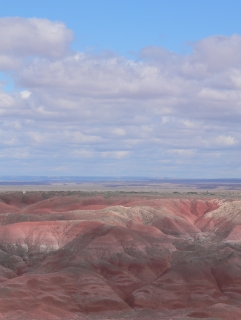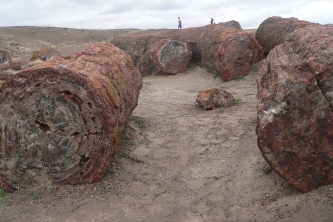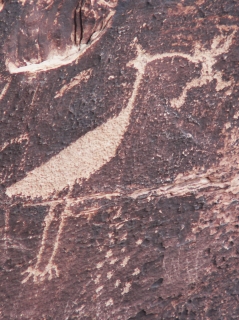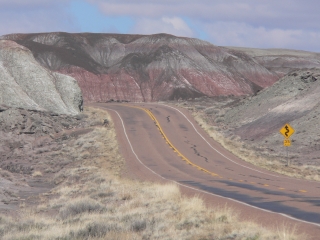NPS Website; Local Website
 WHAT IS IT?
WHAT IS IT?One of the world’s largest collections of multihued and very ancient petrified wood. The Park is also home to sprawling badlands fields shaded in pinks, reds and orange and known as the Painted Desert.
BEAUTY (8/10)
The Park newspaper labels Petrified Forest as “Two Parks in One”. They are being modest. We count at least five, but more on that later. Visually, the Site really is two separate parks, the Petrified Forest and the Painted Desert. Both are noted for their rainbow conglomerations, just on different scales.
The Petrified Forest is at first glance an arid, dusty moon-like surface. Then you look closely at the ancient and impossibly heavy petrified wood. The colors sparkle, yellows, oranges, reds, purples and all shades in between. These rough edged behemoths are beautiful, sparkling, illuminating and changing colors like uncut diamonds.
The Painted Desert shares the same glistening hues, except they must be viewed in a gigantic horizontal scale, their fiery glow tempered by the huge blue sky. The desert badland’s colors change too as the sun retreats and the shadows move.
Do not expect to stay for sunset. During the summer, the NPS closes and locks the Park’s gates at 7pm, making the desert’s radiant oranges a scene known only in postcards. Winter hours are even shorter with the gates closing at 5pm. Your only chance for a Painted Desert sunset may be during the winter solstice. There is no on-site campground and the Painted Desert Inn is closed for renovations.
HISTORICAL INTEREST (6/10)
The history taught at the Park spans from intact dinosaur skeletons found within its boundaries and displayed at the Rainbow Forest Museum to rocks littered with pre-Columbian petroglyphs to America’s road, Route 66. The film shown at the Painted Desert Visitor Center does a good job at introducing these fascinating histories but it is up to you to further your studies while on the scenic drive.
 CROWDS (5/10)
CROWDS (5/10)Petrified Forest NP sees large crowds because of its easily accessible location. These crowds did not affect our visit since there are so many pullouts, overlooks and parking spaces. There is enough here to keep plenty of people happy.
Nonetheless, from the time you enter the Park, signs, pamphlets, the Park Newspaper, museum exhibits, and Rangers remind the visitor not to remove any petrified wood. An exhibit at the Rainbow Forest Museum insists that 1,000 of pounds of wood are stolen every week and that the stolen wood carries evil curses. Michael was so spooked that he wanted to leave the Park immediately. A newspaper insert actually asks you to spy on your fellow tourists and report them if you see them stealing wood. A report form is included in your welcome material.
We do not understand why anyone would want to steal natural resources from a National Park Site and found the warnings condescending and insulting. Then we got to thinking about how so many Parks now allow oil drilling and other “resource management” for governmental profit. Then our heads started to hurt from philosophical relativism, so we decided to appreciate the nice scenery. After that, we had a much better time.
EASE OF USE/ACCESS (4/5)
The Petrified Forest NP is the perfect road trip National Park. It is located right off Interstate 40, along what once was Route 66, the classic American road. A detour of the Interstate and through the Park will cost you almost no additional miles.
Going the traditional Horace Greeley direction of east to west get off at Exit 311, continue through the Park and follow U.S. Route 180 back to Holbrook and Interstate Exit 285. Just reverse the course if you are going back east. The distance through the Park from Exit 311 to Exit 285 is 41 miles, just 15 more than you would have driven on I-40.
Nearly all of the Park’s stunning vistas, petroglyphs, pueblo ruins and petrified wood are visible just a short distance from the parking pull off. In addition, most of the pathways from the parking lots are paved. Petrified Forest NP is as user-friendly as they come.
CONCESSIONS/BOOKSTORE (5/5)
The NPS bookstores stocked with hundreds of excellent titles and they are accompanied by the always charming and historic Fred Harvey curio shops.
The two NPS bookstores shelve dozens of Route 66 books, Route 66 DVD’s, every Tony Hillerman mystery, jigsaw puzzles and some explaining everything you have always wanted to know about petrified wood. There is a full wall of postcards including the classic reprints of the depression-era Works Progress Administration National Park posters. We bought them all. The neatest item for sale was a children’s discovery map of Petrified NP that stands at least three feet tall that requires its owner to color in the Park’s many attraction. A giant coloring book map. What a way to remember a vacation.
The curio shops sells the familiar southwest Native American art, T-shirts, hats and everything imaginable emblazoned with Petrified Forest NP. Among its quirkier items are slabs of concrete that reputedly were a part of Route 66 and gobs of petrified wood mined just outside the park barriers. If the wood taken from inside the Park is cursed, we are not testing our luck on any wood whatsoever. Not even a magnet.
 COSTS (3/5)
COSTS (3/5)The Site costs $10 per vehicle or is free with the National Parks Pass. The entrance sign states that entry is $5 if you are on foot. We shudder to think of someone walking through the desert heat and into the Park; the nearest town is Holbrook, Ariz. 19 miles from the southern entrance.
In an incredible fit of luck, a Navajo woman was giving away free samples of her home-made salsa and sopapillas at the Visitor Center. We immediately reverted to Gab’s Costco giveaway mindset, gathering and gobbling down as many delicious morsels as politeness allowed.
RANGER/GUIDE TO TOURIST RATIO (3/5)
There were numerous Rangers posted at both Visitor Centers. During spring months, two Ranger talks are given daily, one at 10am at the southern VC and the other at 2pm at the Puerco Pueblo ruin located in the middle of the scenic drive.
TOURS/CLASSES (7/10)
We arrived at 10:45am, narrowly missing the first talk. We did not stick around Puerco Pueblo long enough to hear the second. The southern VC, the Rainbow Forest Museum, is undergoing a large renovation. It currently showcases a nice array of dinosaur skeletons and polished petrified wood. We oohed and aahed alongside all the kids.
The introductory video we watched at the northern Painted Desert VC was terrific and alerted us to the Park’s historical significance that had escaped our mind while we took the scenic drive. Namely, Route 66 and the history of American road trips. We wished that we could have watched the film at the beginning of our Park trip rather than the end.
FUN (6/10)
Michael was totally spooked by the display of letters and apologies to the Park Service returning pieces of petrified wood, always after years and years of misfortune plagued the takers. It felt a bit heavy handed, as did the ubiquitous signs posted along every self-guided trail. We don’t want your wood, alright?!?
The scenic drive is long enough that we were able to shake the bad vibes a few miles into it. After pullout after pullout highlighting ancient pueblos, petroglyphs, stunning vistas and more petrified wood, we completely forgot any negative first impressions. You and hundred of other motorists are taking a journey through one of America’s National Parks. These are the things road trips are made of. The great movie and free food at the end of our drive ensured fond memories.
 WOULD WE RECOMMEND? (8/10)
WOULD WE RECOMMEND? (8/10)Yes, the Park is a perfect short scenic detour on your way to many things: the bustling nightlife of wonderful Flagstaff to the west or Albuquerque to the east; the Grand Canyon, Santa Fe, Las Vegas or even the ends of old Route 66, Los Angeles and Chicago.
TOTAL 55/80
www.usa-c2c.com
© 2004-06